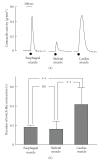Contractile properties of esophageal striated muscle: comparison with cardiac and skeletal muscles in rats
- PMID: 20379364
- PMCID: PMC2850148
- DOI: 10.1155/2010/459789
Contractile properties of esophageal striated muscle: comparison with cardiac and skeletal muscles in rats
Abstract
The external muscle layer of the mammalian esophagus consists of striated muscles. We investigated the contractile properties of esophageal striated muscle by comparison with those of skeletal and cardiac muscles. Electrical field stimulation with single pulses evoked twitch-like contractile responses in esophageal muscle, similar to those in skeletal muscle in duration and similar to those in cardiac muscle in amplitude. The contractions of esophageal muscle were not affected by an inhibitor of gap junctions. Contractile responses induced by high potassium or caffeine in esophageal muscle were analogous to those in skeletal muscle. High-frequency stimulation induced a transient summation of contractions followed by sustained contractions with amplitudes similar to those of twitch-like contractions, although a large summation was observed in skeletal muscle. The results demonstrate that esophageal muscle has properties similar but not identical to those of skeletal muscle and that some specific properties may be beneficial for esophageal peristalsis.
Figures




Similar articles
-
Postnatal changes in vagal control of esophageal muscle contractions in rats.Life Sci. 2012 Apr 9;90(13-14):495-501. doi: 10.1016/j.lfs.2012.01.004. Epub 2012 Jan 20. Life Sci. 2012. PMID: 22285836
-
ATP-dependent potassium channels contribute to motor regulation of esophageal striated muscle in rats.J Vet Med Sci. 2019 Sep 3;81(9):1266-1272. doi: 10.1292/jvms.19-0197. Epub 2019 Jul 9. J Vet Med Sci. 2019. PMID: 31292350 Free PMC article.
-
Inhibitory action of hydrogen sulfide on esophageal striated muscle motility in rats.Eur J Pharmacol. 2016 Jan 15;771:123-9. doi: 10.1016/j.ejphar.2015.12.018. Epub 2015 Dec 11. Eur J Pharmacol. 2016. PMID: 26687631
-
Reduced effect of caffeine on twitch contraction of oesophageal striated muscle from stroke-prone spontaneously hypertensive rats.Clin Exp Pharmacol Physiol. 2003 Apr;30(4):223-31. doi: 10.1046/j.1440-1681.2003.03819.x. Clin Exp Pharmacol Physiol. 2003. PMID: 12680839
-
Neuromuscular mechanisms of primary peristalsis.Am J Med. 1997 Nov 24;103(5A):40S-43S. doi: 10.1016/s0002-9343(97)00320-3. Am J Med. 1997. PMID: 9422621 Review.
Cited by
-
Effect of inter-swallow interval on striated esophagus peristalsis; a comparative study with smooth muscle esophagus.Neurogastroenterol Motil. 2023 Aug;35(8):e14608. doi: 10.1111/nmo.14608. Epub 2023 May 8. Neurogastroenterol Motil. 2023. PMID: 37154414 Free PMC article.
-
Purinergic inhibitory regulation of esophageal smooth muscle is mediated by P2Y receptors and ATP-dependent potassium channels in rats.J Physiol Sci. 2024 Apr 23;74(1):26. doi: 10.1186/s12576-024-00916-5. J Physiol Sci. 2024. PMID: 38654149 Free PMC article.
-
Activation of KCNQ channels located on the skeletal muscle membrane by retigabine and its influence on the maximal muscle force in rat muscle strips.Naunyn Schmiedebergs Arch Pharmacol. 2016 Apr;389(4):439-46. doi: 10.1007/s00210-016-1211-0. Epub 2016 Jan 27. Naunyn Schmiedebergs Arch Pharmacol. 2016. PMID: 26815201
-
Impaired contractility of the circular striated urethral sphincter muscle may contribute to stress urinary incontinence in female zucker fatty rats.Neurourol Urodyn. 2017 Aug;36(6):1503-1510. doi: 10.1002/nau.23165. Epub 2016 Oct 29. Neurourol Urodyn. 2017. PMID: 27794188 Free PMC article.
References
-
- Izumi N, Matsuyama H, Yamamoto Y, et al. Morphological and morphometrical characteristics of the esophageal intrinsic nervous system in the golden hamster. European Journal of Morphology. 2002;40(3):137–144. - PubMed
-
- Shiina T, Shimizu Y, Izumi N, et al. A comparative histological study on the distribution of striated and smooth muscles and glands in the esophagus of wild birds and mammals. Journal of Veterinary Medical Science. 2005;67(1):115–117. - PubMed
-
- Wörl J, Neuhuber WL. Enteric co-innervation of motor endplates in the esophagus: state of the art ten years after. Histochemistry and Cell Biology. 2005;123(2):117–130. - PubMed
-
- Bieger D, Hopkins DA. Viscerotopic representation of the upper alimentary tract in the medulla oblongata in the rat: the nucleus ambiguus. Journal of Comparative Neurology. 1987;262(4):546–562. - PubMed
-
- Cunningham ET, Jr., Sawchenko PE. Central neural control of esophageal motility: a review. Dysphagia. 1990;5(1):35–51. - PubMed
Publication types
MeSH terms
Substances
LinkOut - more resources
Full Text Sources
Miscellaneous
